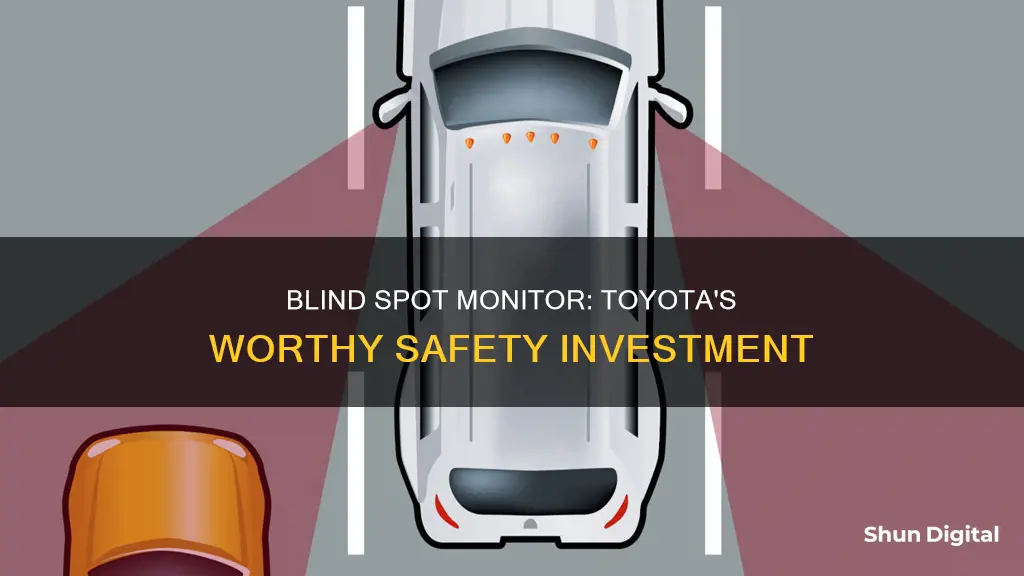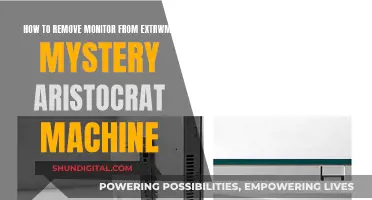
Blind-spot monitoring is a sought-after driver aid that is offered as a feature upgrade by automakers such as Toyota, Lexus, Nissan, Ford, Tesla, Audi, and BMW. While the technology is intended to promote safe driving, its effectiveness in practice is questionable. This paragraph aims to introduce the topic of whether Toyota's blind-spot monitor is worth the upgrade price and explore the potential benefits and drawbacks of this technology.
| Characteristics | Values |
|---|---|
| Safety | Blind-spot monitoring is considered a safety feature by some, but others argue that it is a convenience item. |
| Effectiveness | Blind-spot monitoring is effective at preventing collisions. A study by the Insurance Institute for Highway Safety found that vehicles equipped with blind-spot monitoring systems were 14% less likely to be involved in a lane-change crash than those without it. |
| Drawbacks | Blind-spot monitoring systems struggle to detect fast-moving vehicles and motorcycles. They may also be ineffective in well-lit conditions. |
| Cost | The cost of blind-spot monitoring varies depending on the automaker. Toyota charges $680 for the feature on the base model Camry, while Honda charges over $2,000 for the Accord and CR-V. |
| User Experience | User experiences vary. Some users find blind-spot monitoring useful, while others find it annoying and prefer to rely on their mirrors and surroundings. |
What You'll Learn

Toyota's blind spot monitor is called the Blind Spot Monitor
The BSM uses side- and rear-mounted sensors to scan the areas alongside and behind your vehicle. When these sensors detect an object, they will trigger a light in the driver’s line of sight to indicate that it is not safe to move over. The system will also beep and flash the blind-spot-warning light if the driver switches on a turn signal in the direction of the detected object.
The BSM is typically “on” by default, but there is an option to turn it off. Toyota includes the BSM on mid- and high-level variants of the popular Camry sedan and RAV4 compact crossover, but base-model buyers have to pay extra for it.
While the BSM is a valuable feature that can help prevent accidents, it may not be as effective in detecting fast-moving vehicles or motorcycles. Additionally, since the BSM relies on visual cues on the side mirror, it may be difficult for the driver to notice the signal in time, especially with bright lights or other outside circumstances.
Despite some limitations, the BSM is a useful tool that can provide an extra layer of security for drivers. It is important to remember that the BSM should not be solely relied on, and drivers should still check their blind spots and follow best practices when changing lanes or turning.
Troubleshooting TCP Port Monitor 1801 Unavailability
You may want to see also

The monitor is worth it for safety and resale value
Blind-spot monitoring is a useful feature for safety and resale value. It is an extra security measure that warns you not to make a lane change at that moment by alerting you when someone is hanging out in the hard-to-see area just behind your shoulder. It is especially useful when backing out of a parking spot or driveway, as it can detect cars and people that you might not see otherwise.
A study by the Insurance Institute for Highway Safety found that vehicles equipped with blind-spot monitoring systems were 14% less likely to be involved in a lane-change crash than those without it. Having blind-spot monitoring also reduces the rate of lane-change crashes with injuries by 23%. It is also a feature that is sought after by used-car buyers.
While it may not be necessary for some, it is a useful feature to have, especially if you intend to keep the car for a long time. It is always better to have an extra layer of security when it comes to safety.
Toyota includes blind-spot monitoring on mid- and high-level variants of the popular Camry sedan and RAV4 compact crossover but makes base-model buyers pay extra for it. It is a worthwhile investment, not only for safety but also for the resale value of your car.
Analog vs Digital Monitors: How to Distinguish?
You may want to see also

It's a useful feature for backing out of parking spots
The blind-spot monitor is a useful feature for backing out of parking spots. It is especially helpful when backing out of a narrow parking spot, where it can be challenging to see down the street behind you. The system uses sensors to detect approaching vehicles or pedestrians in the adjacent lanes and provides an audible or visual warning to alert the driver. This can be invaluable when backing out of a parking space between two large vehicles, as it helps to ensure that you don't miss spotting someone walking or driving behind your car.
The blind-spot monitor can also be helpful when navigating busy streets or parking lots, where people may be walking or driving quickly behind your vehicle. The system will alert you to their presence, even if you may not have seen them yourself. This can be particularly useful if you live on a busy street or near an elementary school, where children may be running or riding their bikes.
Additionally, the blind-spot monitor can provide peace of mind when driving on multi-lane highways or busy roads at night. The system will alert you if there is a vehicle in your blind spot, allowing you to make lane changes or turns with more confidence.
While the blind-spot monitor is a valuable feature, it is important to note that it should not be solely relied upon. It is always essential to check your mirrors and surroundings and make sure it is safe before changing lanes or backing out of a parking spot.
Best 240Hz Monitors: Elevate Your Gaming Experience
You may want to see also

It's especially useful for larger vehicles
Blind-spot monitoring is a useful feature for any vehicle, but it is especially beneficial for larger vehicles such as trucks and SUVs. The size of these vehicles can make it challenging to check blind spots effectively, and the system provides an extra layer of security by alerting the driver to the presence of other vehicles or obstacles. This can be invaluable when backing out of a parking spot or merging onto a busy highway.
The National Highway Safety Administration reports that over 800,000 blind spot accidents occur each year, highlighting the importance of this safety feature. While mirror adjustments and proper driving techniques are essential, blind-spot monitoring offers an additional safeguard that can prevent collisions and improve overall driving experience.
Toyota offers blind-spot monitoring as a feature upgrade, and it is well worth considering if you plan to keep your vehicle for an extended period. While it may not be necessary for all drivers, those who frequently navigate busy roads or have limited mobility will find it particularly advantageous.
The system's effectiveness is supported by research. A study by the Insurance Institute for Highway Safety found a 14% reduction in lane-change crashes for vehicles equipped with blind-spot monitoring. Additionally, there was a 23% decrease in lane-change collisions with injuries and a 7% decrease in claim rates for damage to other vehicles. These statistics underscore the value of blind-spot monitoring in enhancing safety and reducing the risk of accidents.
While some drivers may find the alerts annoying or prefer to rely solely on their driving skills, blind-spot monitoring can provide valuable assistance, especially when dealing with fast-moving vehicles or motorcycles, which can be more challenging to detect. It is important to note that this technology should be used as a supplementary tool rather than a replacement for safe driving practices.
In conclusion, blind-spot monitoring is a valuable feature for larger vehicles, enhancing safety and providing peace of mind. While it may come at an additional cost, the potential benefits of avoiding accidents and improving overall driving experience make it a worthwhile investment for many drivers.
Abbott Precision Xtra Glucose Ketone Monitor: Buying Guide
You may want to see also

It's not a replacement for checking blind spots
While blind-spot monitoring systems are a great feature to have, they are not a replacement for checking blind spots. They are meant to act as an extra security measure, warning you not to make a lane change if there is a car in your blind spot. However, it is still important to follow best practices and physically check your blind spot when changing lanes or turning.
The effectiveness of blind-spot monitoring systems has been called into question by some studies. For example, a study by the American Automobile Association (AAA) found that these systems struggled to detect fast-moving vehicles and would often alert drivers too late to take action. Additionally, the systems had difficulty detecting motorcycles, with motorcycles being detected 26% later than passenger vehicles.
Another potential drawback of blind-spot monitoring systems is their reliance on visual or audio cues, which may be difficult for the driver to notice in time, especially in circumstances with bright lights or when the audio cues are only provided when the turn signal is activated.
In conclusion, while blind-spot monitoring systems can be a valuable tool for drivers, they should not be solely relied upon. It is important for drivers to remain vigilant and actively check their blind spots to ensure safe driving.
Troubleshooting a Monitor That Won't Display a Signal
You may want to see also
Frequently asked questions
Blind spot monitoring is a sought-after feature that can cost as little as a few hundred dollars or as much as a couple of thousand. Toyota includes blind spot monitoring on mid- and high-level variants of the Camry and RAV4 but makes base-model buyers pay extra. On the entry-level Corolla, for example, it's a $1,340 option.
Blind spot monitoring uses side- and rear-mounted sensors to scan the areas alongside and just behind your vehicle. When these sensors detect an object, they trigger a light in the driver's line of sight and may also beep to indicate that it's not safe to move over.
Blind spot monitoring is intended to prevent lane-change crashes, and it seems to be effective. A study by the Insurance Institute for Highway Safety found that vehicles equipped with blind-spot monitoring systems were 14% less likely to be involved in a lane-change crash than those without it. Having blind-spot monitoring also reduces the rate of lane-change crashes with injuries by 23%. However, blind-spot monitoring systems have been found to struggle with detecting fast-moving vehicles and motorcycles.
Blind spot monitoring provides an extra layer of security when driving. Even if you are diligent about checking your mirrors and surroundings, it can be easy to miss a vehicle in your blind spot, especially when driving at night or in poor weather conditions.
One of the biggest issues with blind-spot monitoring systems is their ability to detect fast-moving vehicles efficiently. Studies have found that alerts are often provided too late for the driver to take action. Additionally, since most systems use visual cues on the side mirror, it may be difficult for the driver to notice the signal, especially if they are dealing with bright lights or other distractions.







